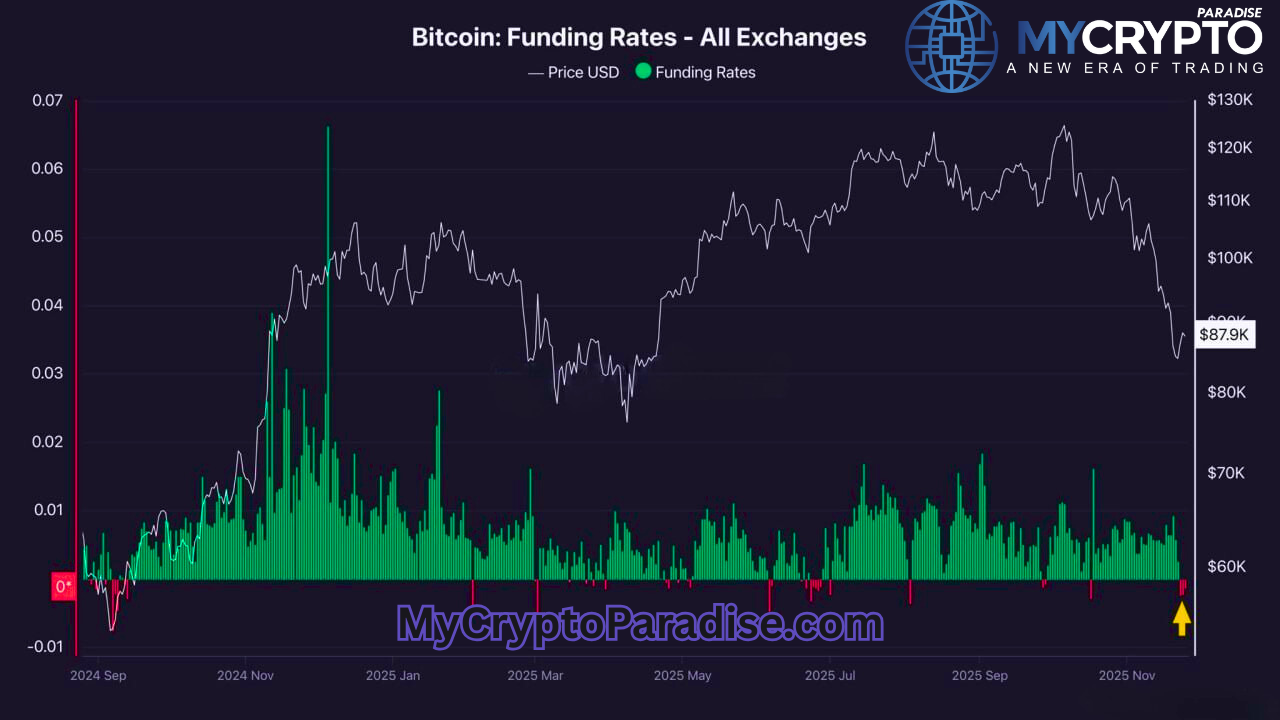- As a crypto trader, you can use harmonic patterns to spot high-probability reversal zones by combining Fibonacci ratios with precise price structure analysis.
- You can improve your crypto trading results by confirming harmonic setups with indicators like RSI and MACD, while applying disciplined risk management.
- By using advanced charting platforms, Fibonacci tools, and indicators, you can trade crypto like a PRO with accuracy and consistency.
Harmonic patterns provide crypto traders with a mathematical edge by combining Fibonacci ratios with geometric price structures to pinpoint reversal zones. Unlike traditional chart patterns, harmonic patterns demand strict ratio alignment.
In this article, we’ll discuss the harmonic pattern and its types. We will also show you how to trade these patterns with accuracy and share tools to spot patterns.
What Are Harmonic Patterns?
Harmonic Patterns are a specialized branch of technical analysis that combines geometry and Fibonacci mathematics to identify potential reversal points in the market. Unlike traditional chart patterns that rely on subjective interpretation, harmonic patterns use strict Fibonacci ratios to define the structure and boundaries of each pattern.
This mathematical precision removes much of the guesswork, enabling PRO crypto traders to approach the market with clarity and confidence.
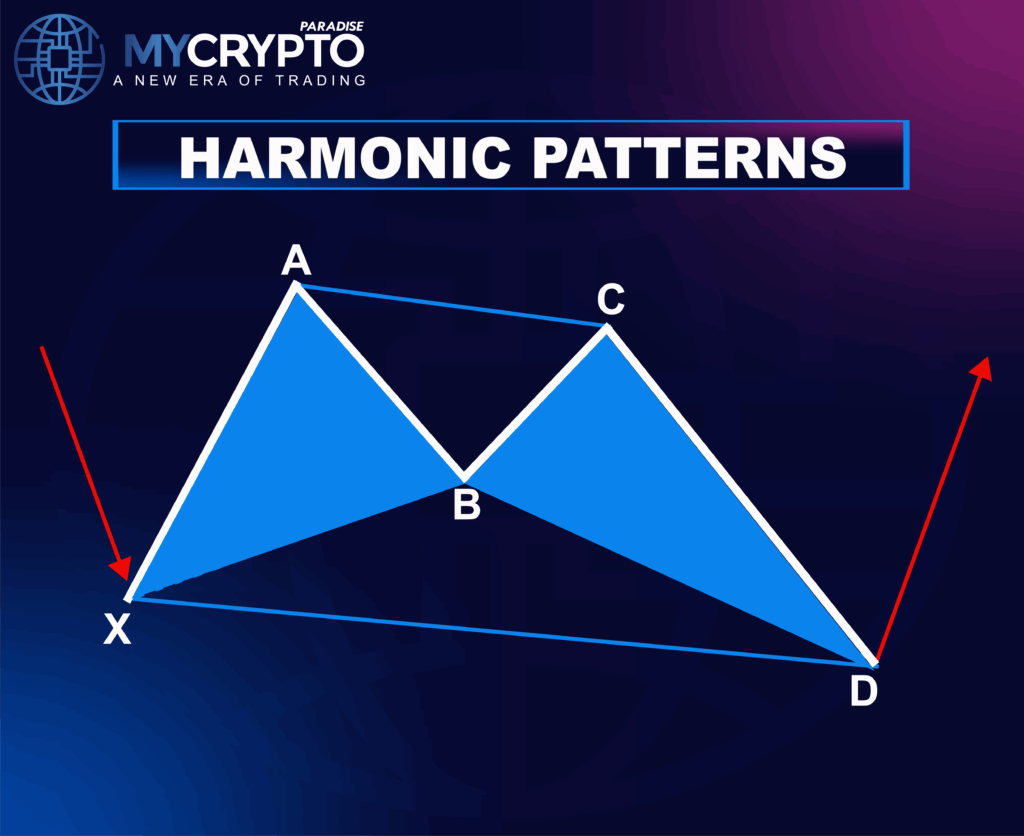
At their core, harmonic patterns consist of a series of price swings (labeled X, A, B, C, and D) that form geometric shapes, such as the famous Gartley, Bat, Butterfly, and Crab patterns. Each leg corresponds to specific Fibonacci retracement or extension levels, which have been historically proven to indicate where price is likely to reverse or continue.
Why are Harmonic Patterns Important?
The volatility of the crypto market can be overwhelming and makes it harder to locate the reversal. Harmonic patterns help crypto traders:
- Enter positions before most traders spot the move
- Place tighter stop-losses for controlled risk
- Target high-probability reversal zones for bigger reward potential
Some of the most common harmonic patterns include the Gartley, Bat, Butterfly, Crab, and Cypher. These shapes appear repeatedly across timeframes, from quick Bitcoin scalps to long-term Ethereum swings.
The Mathematical Beauty Behind Harmonic Patterns
At first glance, harmonic patterns might look like just another set of zigzags on a chart. But beneath those lines lies a precise mathematical framework that gives them their edge. These formations are built on Fibonacci ratios. In crypto trading, they help pinpoint where the price is most likely to pause or reverse.
The magic is in the symmetry. A valid harmonic pattern isn’t just a random shape; every leg of the pattern must align with specific Fibonacci retracement or extension levels. This means a Gartley pattern in Bitcoin follows the same mathematical principles as a Bat pattern in Ethereum. So, it provides traders with a universal structure to work with across markets.
For PRO crypto traders, this level of precision offers two major advantages:
- Clarity – There’s no room for vague interpretations; the pattern either meets the criteria or it doesn’t.
- Consistency – Because the rules are fixed, it’s easier to backtest, refine, and apply the method systematically.
When you start looking at the market through this lens, charts begin to feel less like chaos and more like a mathematical map.
Types of Harmonic Patterns
Before you start to trade these patterns, you must know the strict rules for each type. Each pattern offers distinct reversal signals suited for different market conditions. Here’s a breakdown of the most important harmonic patterns every crypto trader should know:
Gartley Pattern
The Gartley is the classic harmonic pattern, often called the “Mother of all harmonics.” It starts with an impulsive X-A move, followed by corrective retracements. Key Fibonacci levels include:
- Point B retraces 61.8% of X-A
- Point C retraces 38.2% to 88.6% of A-B
- Point D completes near 78.6% retracement of X-A (Potential Reversal Zone)
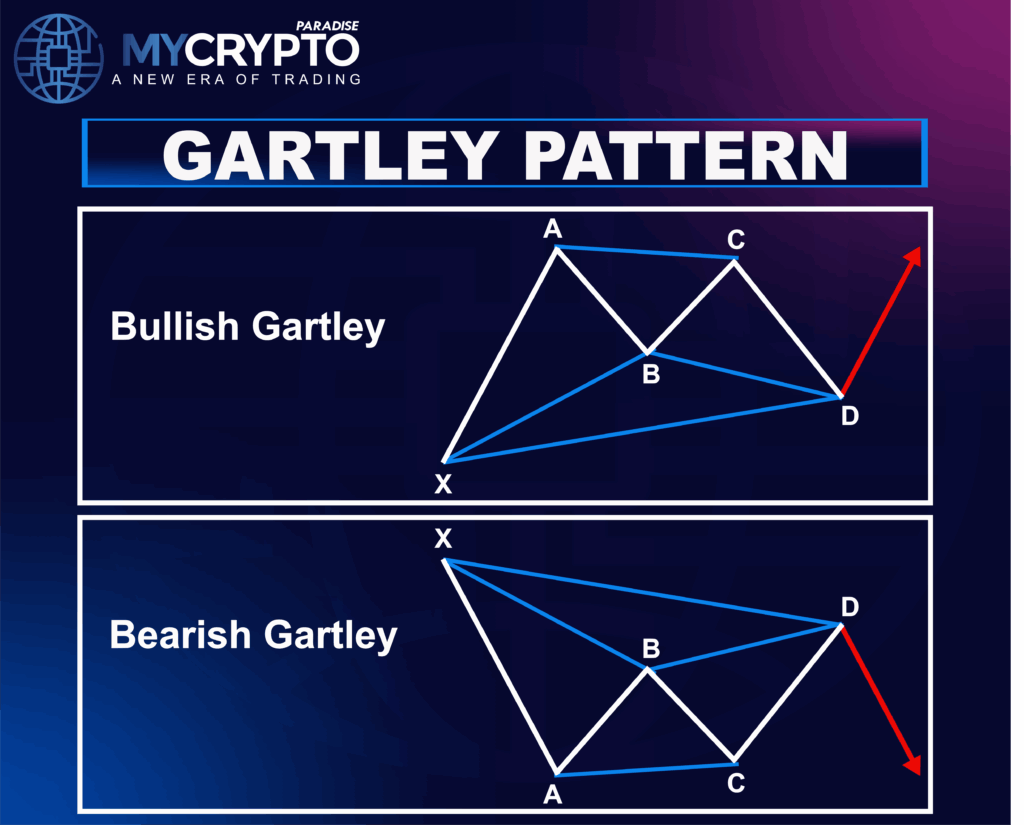
This pattern signals a high-probability reversal and works well in trending markets with clear corrections. Crypto traders must look for bullish Gartleys in dips and bearish Gartleys near exhaustion points.
ABCD Pattern
The ABCD pattern is the simplest and most widely recognized harmonic pattern, forming the foundation for more complex ones. It consists of three price swings creating a symmetrical shape:
- AB and CD legs are typically equal in length (or measured with Fibonacci extensions around 127% to 161.8%)
- BC retraces between 61.8% to 78.6% of AB
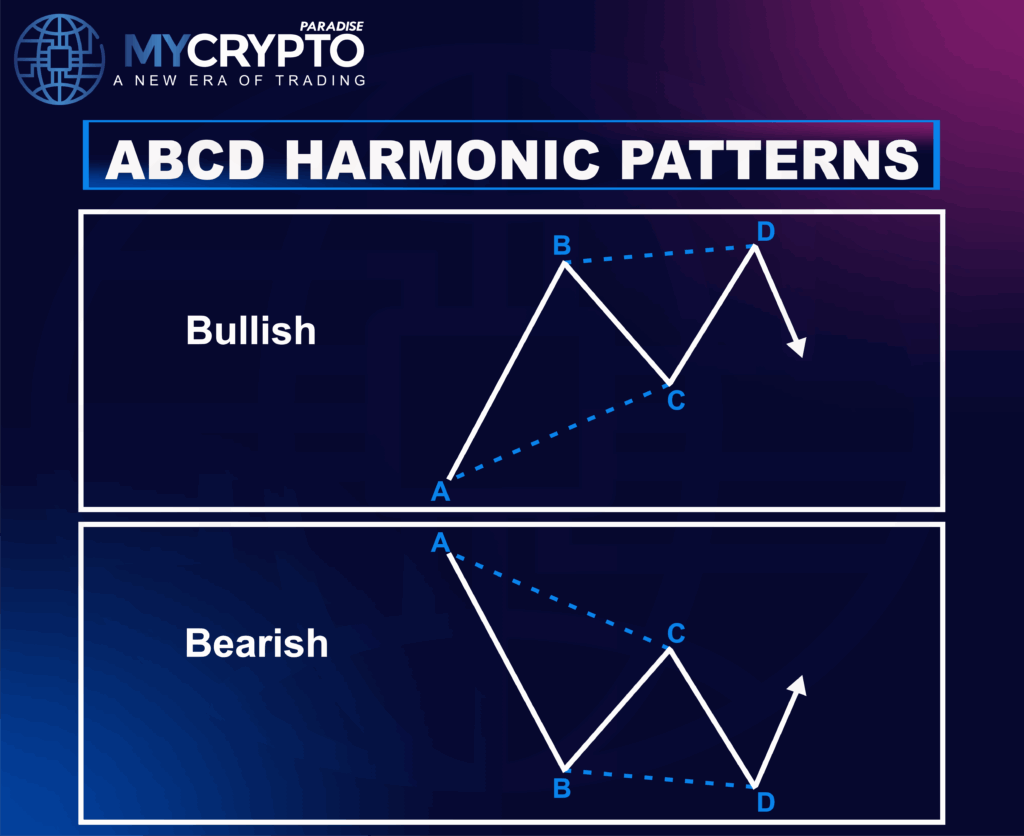
This pattern signals potential reversals with clear entry and exit points, making it ideal for quick, tactical trades in crypto’s volatile environment.
Bat Pattern
Similar to Gartley but with a deeper retracement on point B at 88.6% of X-A, the Bat pattern offers more conservative and safer entry zones.
- Point D lands between 88.6% retracement of X-A, forming the Potential Reversal Zone.
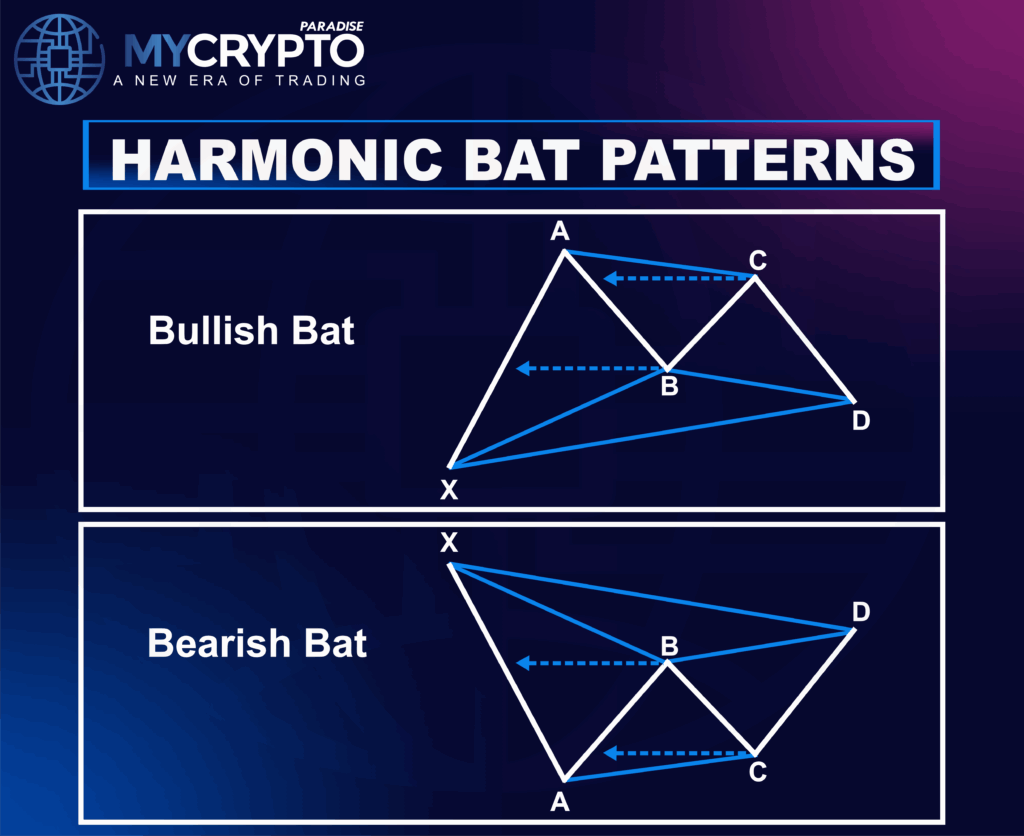
It’s favored for its balance of high accuracy and good risk/reward setups.
Butterfly Pattern
The Butterfly extends beyond the initial X point, making it an ideal pattern for spotting exhaustion reversals after strong trends.
- Point B retraces 78.6% of X-A
- Point D extends to 127% or 161.8% of X-A (Potential Reversal Zone)
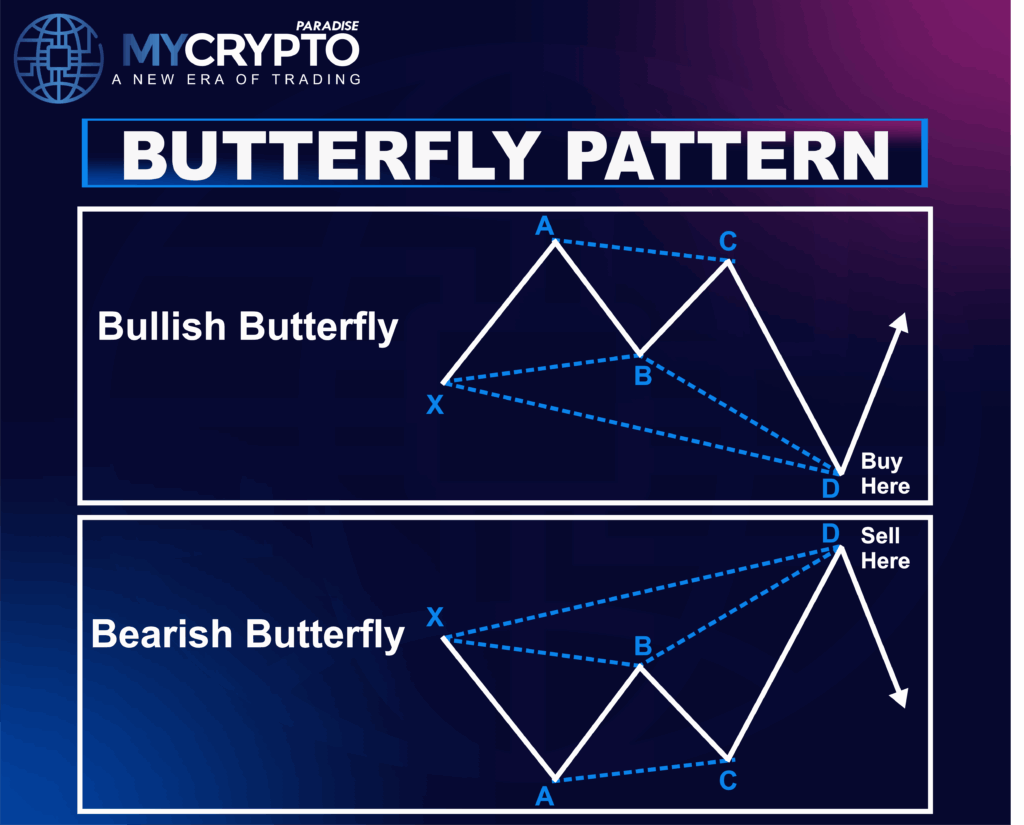
Traders use this pattern to catch trend endings with clear invalidation points.
Crab Pattern
Known for its aggressive price extension, the Crab pattern’s Point D reaches an extreme 161.8% extension of X-A, offering maximum profit potential. It’s especially useful in the volatile crypto market when looking for strong reversals.
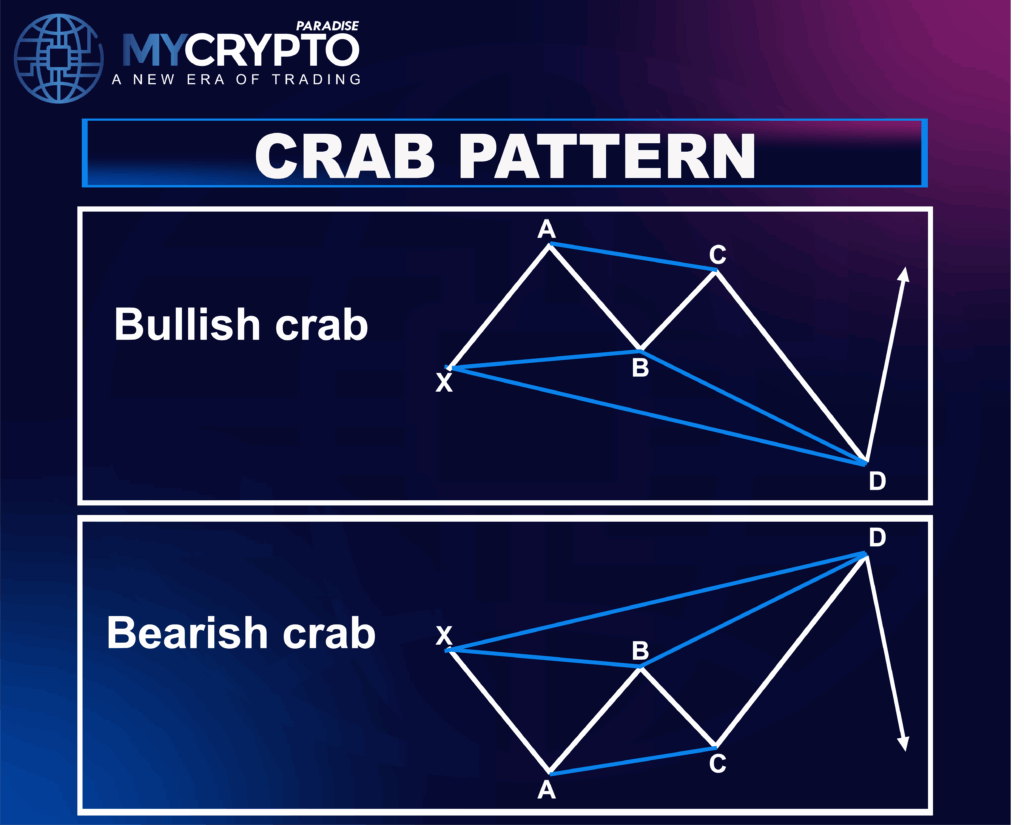
- Point B retraces 38.2% to 61.8% of X-A
- Point C retraces 38.2% to 88.6% of B-A
- Point D completes near 161.8% extension of X-A
Deep Crab
A variation of the Crab, with an even deeper Point B retracement at 88.6%. This pattern demands patience and discipline due to its rarity, but can yield substantial rewards when correctly identified.
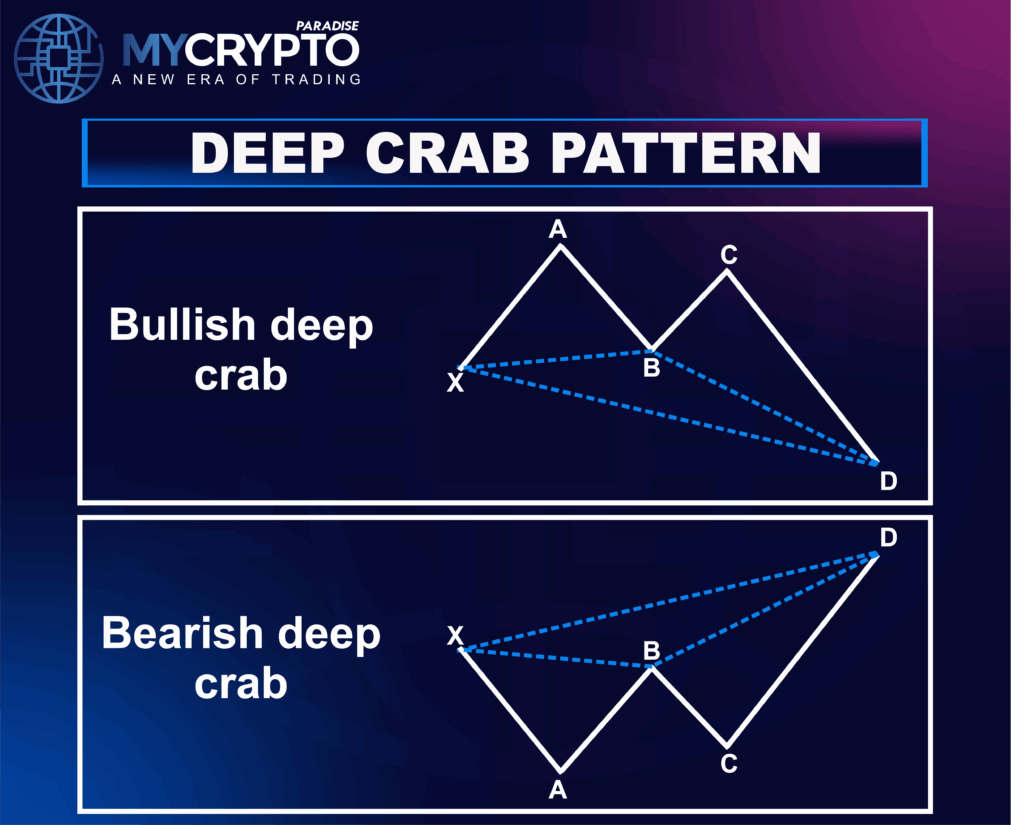
Shark Pattern
The Shark Pattern is a modern harmonic pattern popular among PRO crypto traders for spotting sharp reversals. It uses a unique O-X-A-B structure with key Fibonacci levels:
- Point A retraces 113% to 161.8% of O-X
- Point B completes near 88.6% retracement of X-A (Reversal Zone)
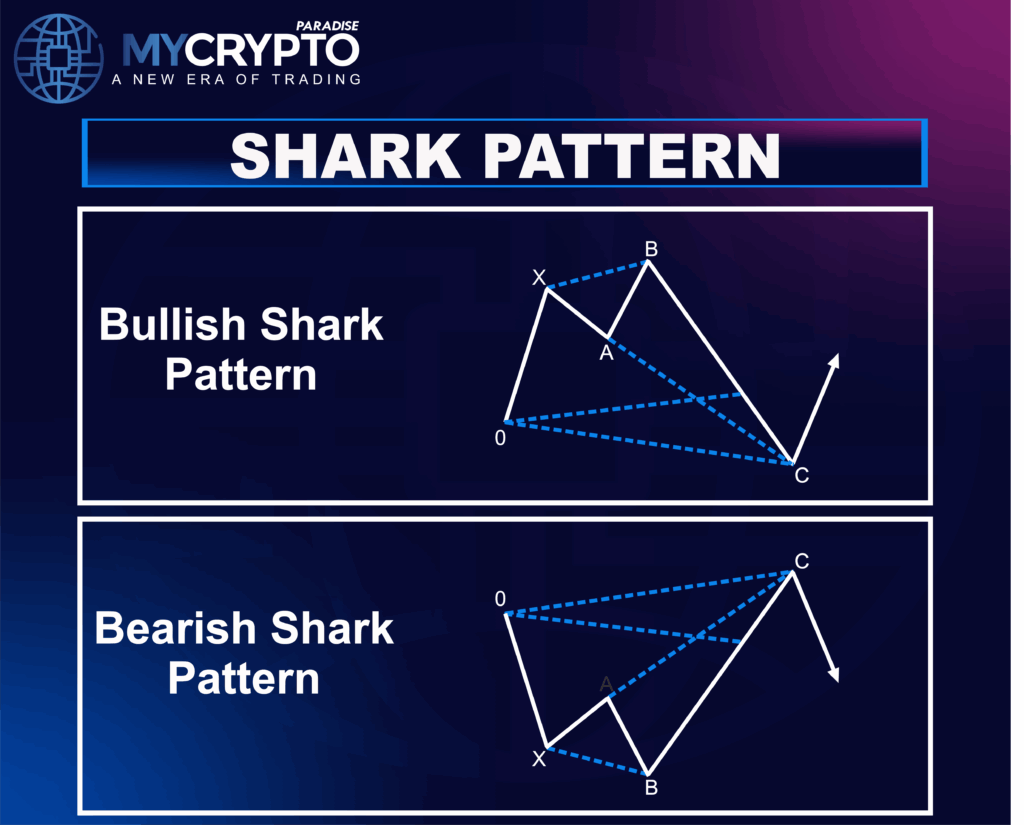
The Shark Pattern is ideal for the volatile crypto market. It offers precise entry and stop levels, helping crypto traders capture early trend exhaustion with controlled risk.
How to Identify Harmonic Patterns in Crypto?
You need to follow a structured process backed by strict Fibonacci measurements to identify Harmonic patterns. You can identify them by:
Identify X, A, B, C, and D Points on the Chart
Every harmonic pattern has five key points: X, A, B, C, and D, which create four distinct legs:
- XA – The initial impulsive move.
- AB – A retracement of the XA leg.
- BC – A smaller move in the opposite direction of AB.
- CD – The final leg that completes the pattern.
At this stage, focus on spotting a zigzag structure that resembles one of the known harmonic patterns (ABCD, Gartley, Bat, Butterfly, Crab, Deep Crab, Shark) before confirming with Fibonacci levels.
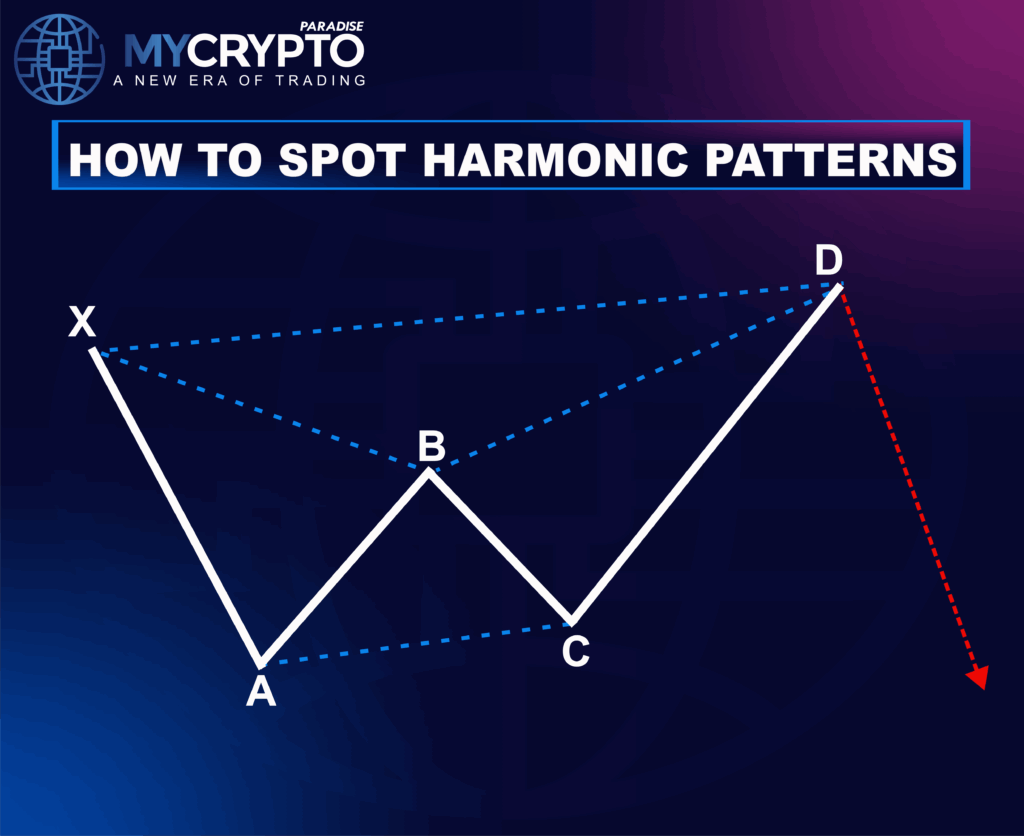
Measure Fibonacci Ratios for Accuracy
Once you identify the rough shape, apply Fibonacci retracement and extension tools to verify that each leg meets the exact ratios for the pattern type.
Common Fibonacci levels for harmonic patterns:
- Retracements: 38.2%, 50%, 61.8%, 78.6%, 88.6%
- Extensions: 113%, 127.2%, 161.8%
For example:
- A Bat Pattern often has a B point at 88.6% retracement of XA.
- A Crab Pattern usually ends at a 161.8% extension of XA.
If the swing points do not align with the required Fibonacci ratios, the pattern is invalid.
Confirm with Additional Indicators
Even with perfect Fibonacci measurements, confirmation is essential to avoid false signals. Professional crypto traders pair harmonic analysis with other tools:
- RSI (Relative Strength Index) – Identifies overbought/oversold zones.
- MACD (Moving Average Convergence Divergence) – Confirms momentum changes.
- Moving Averages (50 or 200 EMA/SMA) – Shows trend direction.
- Volume Analysis – Rising volume near the D point supports a reversal.
Wait for Price Action Confirmation at Potential Reversal Zone (PRZ)
The Potential Reversal Zone (PRZ) is where all Fibonacci projections converge and is the most critical area in harmonic trading.
- Ways to confirm a PRZ reversal:
- Reversal candlestick patterns (hammer, engulfing, doji).
- Break of a short-term trendline.
- Lower timeframe setups showing the same reversal signal.
If you enter without PRZ confirmation, you increase the risk of losses.
How to Trade Harmonic Patterns in Crypto?
Once you’ve identified a valid harmonic pattern, the next step is executing the trade with precision and disciplined money management. Here’s the exact process PRO crypto traders follow:
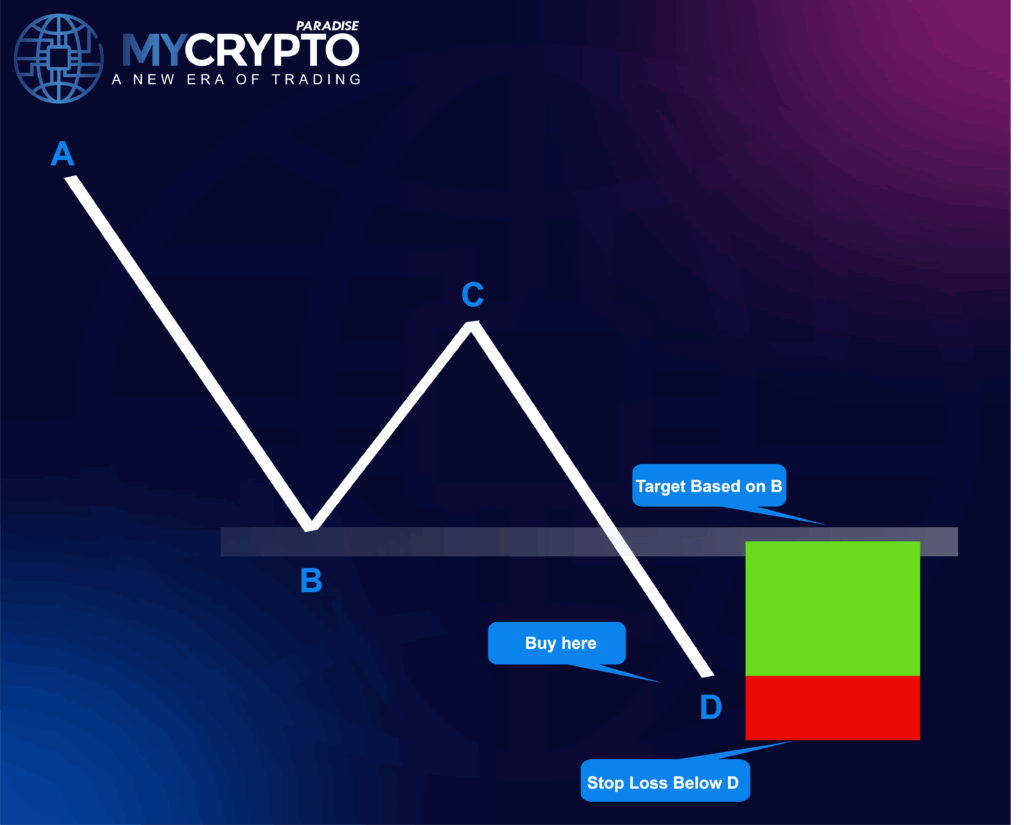
Wait for the Pattern to Fully Complete
Harmonic patterns are only valid once the D point reaches the Potential Reversal Zone (PRZ). Entering early increases the risk of false setups.
- Watch the market closely as the price approaches the PRZ.
- Do not enter a trade until the pattern completes and confirmation signals appear.
Confirm the Setup Before Entering
Even when the pattern is complete, PRO traders validate the setup using technical indicators and price action.
The following are the best confirmation tools:
- RSI Divergence – Overbought or oversold conditions align with the PRZ.
- MACD Crossovers – Momentum shift confirming a reversal.
- Reversal Candlestick Patterns – Engulfing candles, pin bars, or dojis near PRZ.
Place Your Entry Strategically
You need to enter the trade after confirmation, not exactly at the PRZ touch. This reduces the risk of entering during a false breakout.
- For bullish patterns, enter on the first bullish candle close after PRZ reaction.
- For bearish patterns, enter on the first bearish candle close after PRZ reaction.
Set a Protective Stop-Loss
Money management is non-negotiable in harmonic trading. Place your stop-loss just beyond the PRZ to protect your capital.
- For bullish patterns, place stops slightly below PRZ support.
- For bearish patterns, place stops slightly above PRZ resistance.
Plan Multiple Take-Profit Targets
PRO crypto traders lock in profits in stages to maximize gains while minimizing risk.
- First target: 38.2% retracement of the AD leg.
- Second target: 61.8% retracement of the AD leg.
Optional: Leave a portion running toward a deeper retracement or trend continuation.
After the trade closes, log the setup, entry, and outcome. Reviewing past trades helps refine your harmonic strategy and maintain consistency over time. If you’re new to crypto trading or want to increase your gains, reach out to us at ParadiseFamilyVIP 🎖️(Click it)
Helpful Tools for Trading Harmonic Patterns
Trading harmonic patterns in crypto requires the right combination of charting tools, indicators, and automation. The right setup helps you spot patterns faster, confirm their validity, and manage trades like a PRO.
Fibonacci Tools
Fibonacci retracement and extension tools are non-negotiable for harmonic trading. You’ll use them to:
- Measure retracement levels for AB and BC legs.
- Check extension targets for CD completion.
- Identify the Potential Reversal Zone (PRZ) with precision.
The following are common Fibonacci levels used in harmonic patterns: 38.2%, 50%, 61.8%, 78.6%, 88.6%, 113%, 127.2%, 161.8%.
Confirmation Indicators
Harmonic patterns alone are powerful, but pairing them with confirmation indicators increases accuracy. The following are some of the confirmation indicators:
- RSI (Relative Strength Index) – For momentum and reversal confirmation.
- MACD – Shows momentum shifts and potential reversals.
- Moving Averages (50 EMA, 200 EMA) – To align trades with the overall trend.
- Volume Analysis – Confirms the strength of reversals at the PRZ.
With these tools, you can spot, confirm, and execute harmonic setups with the precision and discipline of a professional trader.
Mistakes to Avoid When Trading Harmonic Patterns
Even experienced crypto traders can misread harmonic setups. Avoid these common mistakes to protect your capital and improve consistency:
- Ignoring Fibonacci Ratios – If the legs don’t match the required ratios, it’s not a valid pattern.
- Forcing Patterns on the Chart – Don’t make price movements “fit” just to take a trade.
- Skipping PRZ Confirmation – Always wait for candlestick or momentum signals before entering.
- Overleveraging – Harmonic patterns offer high accuracy but still require strict money management.
- Trading Against the Trend – Use moving averages or higher timeframe analysis to stay aligned with the dominant market direction.
- Neglecting Stop-Loss Placement – Place stop loss beyond the PRZ to avoid being shaken out by minor volatility.
Professional harmonic trading isn’t just about spotting patterns; it’s about discipline, patience, and strategic execution.
Harmonics in Crypto: Do They Work?
Yes, but only when applied with precision, discipline, and realistic expectations. Harmonic patterns can work in crypto trading because they combine geometric price structures with Fibonacci ratios to allow traders to anticipate high-probability reversal zones.
However, crypto markets are more volatile than traditional assets, which means:
- Patterns may complete faster or fail abruptly.
- Wider stop-losses might be needed to account for sudden price spikes.
In the hands of a professional, patient trader, harmonics can be a powerful tool for spotting turning points and managing risk. For inconsistent or emotional traders, they can quickly become a trap.
The bottom line: Harmonic patterns work in crypto, but only as part of a well-structured, disciplined trading strategy.
FAQs
What are harmonic patterns in crypto trading?
Harmonic patterns are advanced chart patterns that use specific Fibonacci ratios to predict potential reversal zones in the market. They help crypto traders identify precise entry and exit points based on price geometry.
Do harmonic patterns really work in the crypto market?
Yes, harmonic patterns can work well in crypto trading when applied correctly with Fibonacci measurements and proper risk management. However, crypto’s volatility means traders should always confirm patterns with other indicators before entering trades.
What is the best harmonic pattern for crypto trading?
There’s no single “best” pattern — success depends on the market context. Professional traders usually use Gartley, Bat, and Crab, while beginners use the ABCD pattern.
How do you trade harmonic patterns in crypto?
To trade harmonic patterns, first identify the X, A, B, C, and D points on the chart, verify Fibonacci ratios, confirm with indicators like RSI or MACD, and then look for price action signals in the Potential Reversal Zone (PRZ).
Can beginners use harmonic patterns?
Beginners can use harmonic patterns, but they require practice and patience. Using a demo account or backtesting on historical charts is recommended before trading them live.
Are harmonic patterns accurate?
Harmonic patterns can be highly accurate when the Fibonacci ratios align perfectly, but they are not foolproof. False signals are possible, especially in highly volatile markets like crypto.
Final Thoughts
Harmonic patterns provide crypto traders a powerful, strategic edge by combining precise Fibonacci ratios with price geometry. When identified and traded correctly, they can signal high-probability reversal zones that help you enter and exit trades with confidence and discipline.
However, success with harmonics requires more than just spotting patterns; it demands patience, strict money management, and confirmation from other technical tools. Treat harmonic trading as part of a professional, systematic strategy rather than a standalone shortcut.
Ready to take your crypto trading to the next level? Explore our free trading guides, PRO strategies, and exclusive crypto signals designed to help you trade smarter and safer.
👉 Join the ParadiseFamilyVIP 🎖️(Click it)
Join the ParadiseFamilyVIP 🎖️ community today and unlock access to expert insights, real-time trade alerts, and a supportive network of serious crypto traders.







